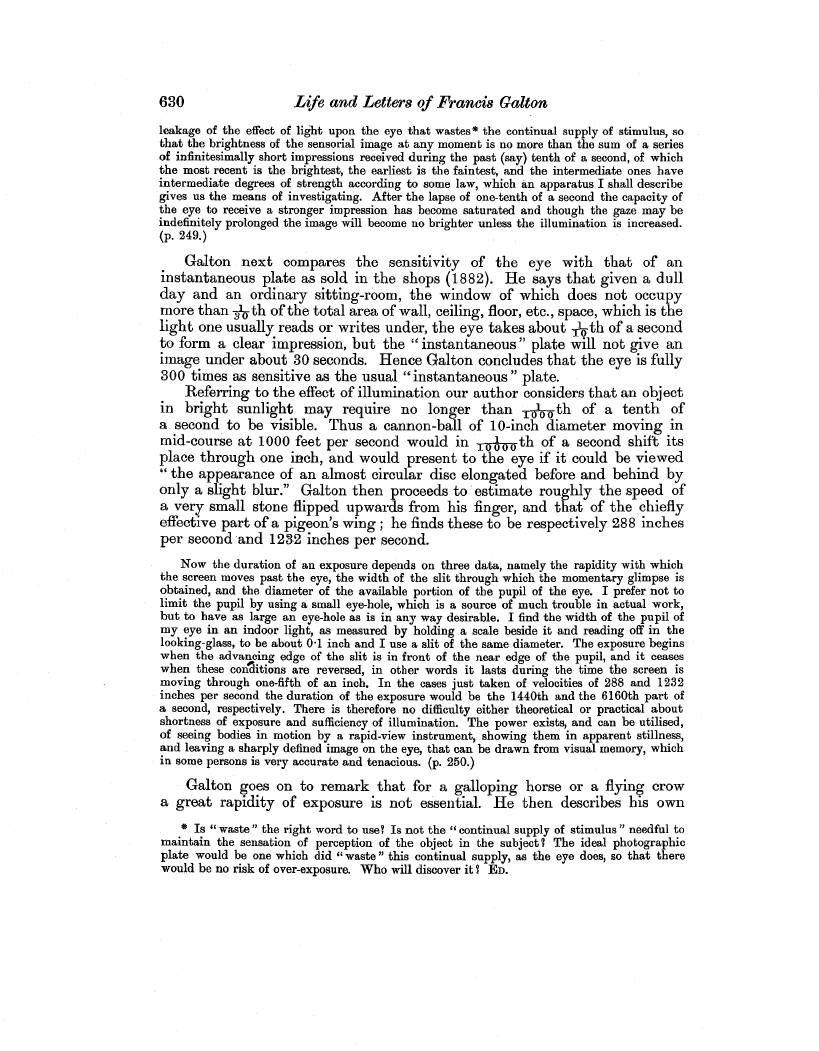| ||||||

OCR Rendition - approximate
630 Life and Letters of Francis Galton leakage of the effect of light upon the eye that wastes* the continual supply of stimulus, so that the brightness of the sensorial image at any moment is no more than the sum of a series of infinitesimally short impressions received during the past (say) tenth of a second, of which the most recent is the brightest, the earliest is the faintest, and the intermediate ones have intermediate degrees of strength according to some law, which an apparatus I shall describe gives us the means of investigating. After the lapse of one-tenth of a second the capacity of the eye to receive a stronger impression has become saturated and though the gaze may be indefinitely prolonged the image will become no brighter unless the illumination is increased. (p. 249.) Galton next compares the sensitivity of the eye with that of an instantaneous plate as sold in the shops (1882). He says that given a dull day and an ordinary sitting-room, the window of which does not occupy more than 5th of the total area of wall, ceiling, floor, etc., space, which is the light one usually reads or writes under, the eye takes about -,&th of a second to form a clear impression, but the " instantaneous " plate will not give an image under about 30 seconds. Hence Galton concludes that the eye is fully 300 times as sensitive as the usual "instantaneous" plate. Referring to the effect of illumination our author considers that an object in bright sunlight may require no longer than T-010 -o th of a tenth of a second to be visible. Thus a cannon-ball of 10-inch diameter moving in mid-course at 1000 feet per second would in 1 o 0 o th of a second shift its place through one inch, and would present to the eye if it could be viewed " the appearance of an almost circular disc elongated before and behind by only a slight blur." Galton then proceeds to estimate roughly the speed of a very small stone flipped upwards from his finger, and that of the chiefly effective part of a pigeon's wing ; he finds these to be respectively 288 inches per second and 123.2 inches per second. Now the duration of an exposure depends on three data, namely the rapidity with which the screen moves past the eye, the width of the slit through which the momentary glimpse is obtained, and the diameter of the available portion of the pupil of the eye. I prefer not to limit the pupil by using a small eye-hole, which is a source of much trouble in actual work, but to have as large an eye-hole as is in any way desirable. I find the width of the pupil of my eye in an indoor light, as measured by holding a scale beside it and reading off in the looking-glass, to be about 0.1 inch and I use a slit of the same diameter. The exposure begins when the advancing edge of the slit is in front of the near edge of the pupil, and it ceases when these conditions are reversed, in other words it lasts during the time the screen is moving through one-fifth of an inch. In the cases just taken of velocities of 288 and 1232 inches per second the duration of the exposure would be the 1440th and the 6160th part of a second, respectively. There is therefore no difficulty either theoretical or practical about shortness of exposure and sufficiency of illumination. The power exists, and can be utilised, of seeing bodies in motion by a rapid-view instrument, showing them in apparent stillness, and leaving a sharply defined image on the eye, that can be drawn from visual memory, which in some persons is very accurate and tenacious. (p. 250.) Galton goes on to remark that for a galloping horse or a flying crow a great rapidity of exposure is not essential. He then describes his own * Is " waste " the right word to use? Is not the L ° continual supply of stimulus " needful to maintain the sensation of perception of the object in the subject? The ideal photographic plate would be one which did " waste " this continual supply, as the eye does, so that there would be no risk of over-exposure. Who will discover it? ED.
|